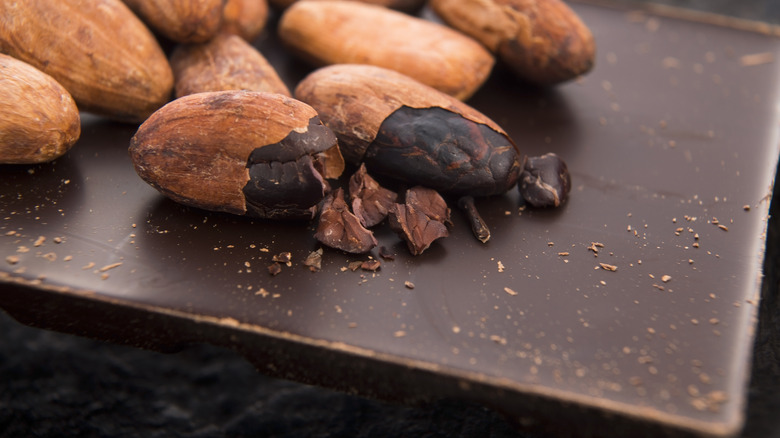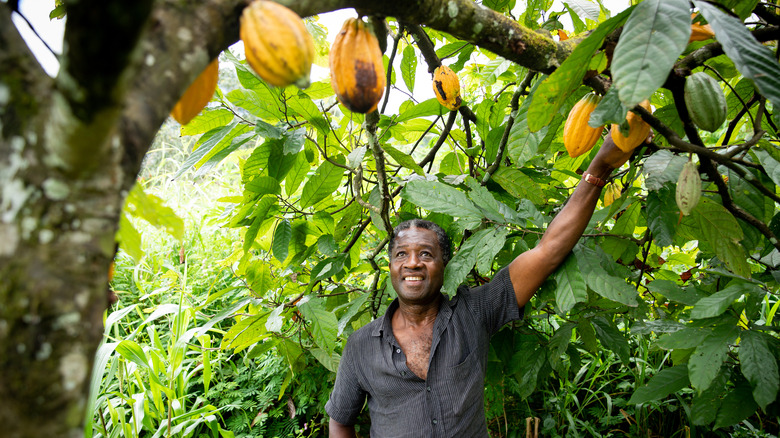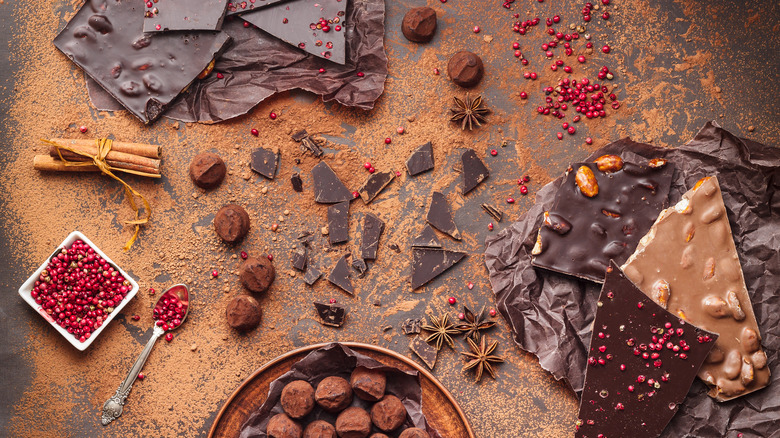Why Bean-To-Bar Is The New Farm-To-Table For Chocoholics
Most Americans eat chocolate daily, according to a 2021 survey by Cargill. It's a day-to-day indulgence, but it's also a special occasion treat, with over 90% of people sharing chocolate and candy with their loved ones during the holiday season (via a 2019 press release from the National Confectioners Association). That's how the nation ended up spending close to a whopping $145 per person per year on the stuff in 2021, according to Statista. The global chocolate market is worth $113 billion and is expected to grow at 3.7% annually between 2022 and 2030 (via Grandview Research). But, one sector of the market is expanding faster than the rest. Bean-to-bar chocolate, per Verified Market Research, is growing at three times that speed — with rates of 11.22% predicted between 2021 and 2027.
According to The Daily Mail, a lot of American chocolate tastes and smells, literally, like vomit. Now, we should note that Hershey's denies that it adds the allegedly offending ingredient (butyric acid) to its bars. But a HuffPost investigation suggested it may well end up there as part of the many secretive and complex processes that go into creating the iconic Pennsylvanian bars — and the company's reluctance to discuss its methods may just fuel the speculation and judgment from foreign chocolate connoisseurs.
Enter bean-to-bar makers. These small brands source and process cacao beans themselves. Per Financial Times, each bar coming from these artisans costs about four times as much as a regular chocolate bar. But is it worth the fuss?
Bean to bar — the people
Opaque processes, long ingredient lists, and snooty comments from Europeans about America's favorite brands resonated with California winemaker John Scharffenberger. According to Wine Spectator, back in the mid-90s, Scharffenberger and business partner Robert Steinberg began their artisanal chocolate factory in Berkeley. In 2005 their company was bought by Hershey for $50 million, per "Bean-to-Bar Chocolate: America's Craft Chocolate Revolution: The Origins, the Makers, and the Mind-Blowing Flavors." And a generation of would-be Willy Wonkas sat up and took notice.
Scharffenberger and Steinberg actually invented the term 'bean-to-bar' to describe how their company's products stood apart from the rest. That started a trend — there were only five bean-to-bar makers back in 2006, and in 2018 there were around 200, per Wine Enthusiast.
There are several reasons the bean-to-bar market is breaking through to the mainstream. There have been shocking revelations about labor practices in many cacao-producing countries, with many farmers living below the poverty line, and, as VICE reported, a level of child slavery built into the system that keeps cheap chocolate cheap. Understandably, outraged customers are demanding change, but some of this progress is allegedly superficial — The Chocolate Journalist claims greenwashing is rife in the industry.
Modern Farmer says bean-to-bar chocolate makers rely on forming genuine connections and relationships with the cacao producers as individual farmers. More than this, a true bean-to-bar maker may ensure ethical practices across the supply chain. When chocolate makers like the Mast Brothers were thought to have a hint of hoodwink about them, they received significant backlash, according to Gothamist.
Bean to bar — the chocolates
As well as buying better peace of mind, bean-to-bar chocolate benefits from better ingredients. Sourcing from estates in ideal locations, bean-to-bar makers pay more for the beans, but they are able to ensure the highest quality crops, according to Chocolate Noise. Though flavorful mix-ins are part of the fun, the beans themselves don't need as much sugar or cocoa butter to be added, let alone the vanilla and soy lecithin that regular chocolate is bulked out with. As Cocoa Box explained, a good rule of thumb with chocolate is that the fewer and simpler the ingredients, the better. Many chocolate makers pride themselves on bars with just two or three ingredients, in total — namely cacao, sugar, and for lighter-tasting bars, cacao butter.
This makes for intense, great-tasting chocolate, but also changes eating chocolate from a guilty pleasure to a pleasurable superfood experience that unlocks the health benefits of cacao (via Mason & Co.). Cacao is surprisingly nutrient-dense, including a wide range of antioxidants and mineral elements like magnesium, potassium, manganese, and iron, per Compare Retreats. It's harder to see the benefits when the cacao is diluted — for example, in 2004 The Washington Post reported that a Hershey's bar was only 11% cacao solids due to all of the added fat, sugar, and dairy.
In short, buying bean-to-bar chocolate does come with a price tag, but it's one way to help assuage your chocolate concerns — from supply chain shortcomings to nutritional worries.


